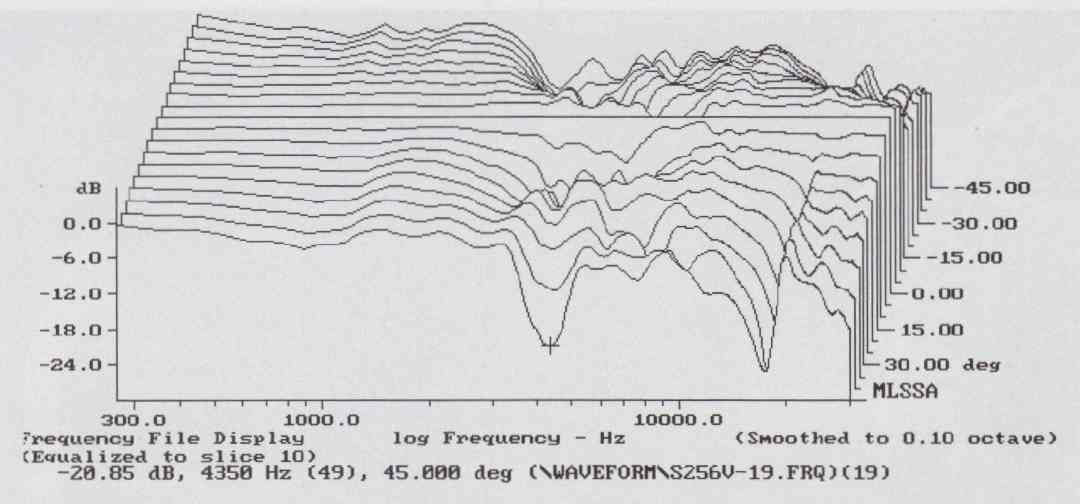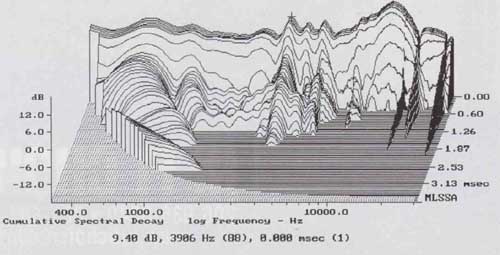Despite their lack of low frequencies, minimonitors have advantages over larger speakers. Small speakers don’t need great quantities of construction materials, so they have relatively low building costs. Their light weight and small size lower shipping Costs. The result is increased value to the Customer. The small panel areas on all sides minimize cabinet-wall vibrations. Also, the four other sides that connect to each panel make good, rigid supports, and no part of any panel is very far from these supports, both minimizing resonances and pushing them up in frequency, where they do less harm to the music.
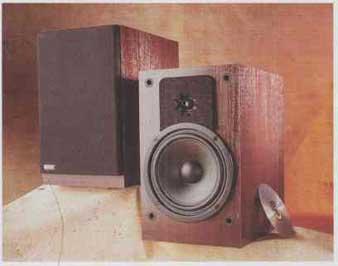
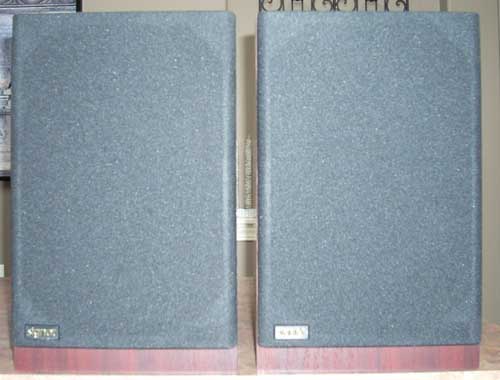
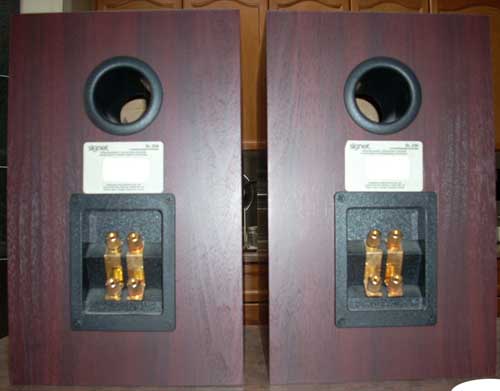
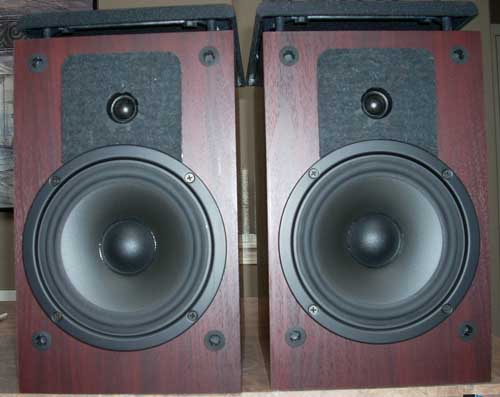
Signet’s inexpensive SL256 mini-monitor allies a silk-dome tweeter to a 6½” polypropylene-cone woofer. Both drivers are proprietary units manufactured in the Far East to Signet’s specifications. The speaker’s grille is a piece of thin fabric stretched over a simple plastic frame. If the grille is removed, the flower-shaped Cutouts in the Sonofelt surrounding the tweeters stand out visually. This pattern has been a characteristic of Signets for many years. The felt slightly narrows the tweeter’s dispersion pattern as well as reducing dif fraction problems.
The Sonofelt’s surface lines up well with the top of the woofer frame, but there is a precipice between the rest of the frame’s edge and the front baffle. This sharp edge, and the 90-degree edges of the baffle itself will theoretically intro duce undesirable diffraction effects. Rabbeting the woofer into the front baffle would have removed one potential source of diffraction, though then the connecting screws could not have dug as deeply into the baffle material as they do. This would have raised the speaker’s price, however.
Removing the connection panel and peeking inside the speaker, I found a generous amount of recycled cotton batting. This lining was bunched up in the bottom half of the cabinet, rather than frilly lining both sides of the interior. The cabinet itself is made of dense, 3 MDF with a 1-thick MDF front baffle. A horizontal brace spanning the interior reduces cabinet side wall vibration.
The crossover operates at 3kHz and is made with high-quality Components. One large air-core inductor is wired in series with the woofer for a first-order low-pass rolloff. The tweeter crossover incorporates an air-core inductor and a polypropylene film capacitor, resulting in a second-order high-pass rolloff.
=== == ====
Description: Two-way, reflex-loaded loudspeaker.
Drive-units: 6 1/2” polypropylene-cone woofer with rubber surround; ¾" silk dome tweeter with ferrofluid cooling
Crossover frequency: 3kHz.
Sensitivity 89dB/W/m
Frequency range 45Hz—20kHz
Nominal impedance 8 ohms.
Recommended amplifier power: 20—100Wpc.
Finishes available: black or mahogany vinyl
Dimensions: (330mm) H by (206mm) W by (320mm) D.
Weight: 16 lbs each.
Serial numbers of units reviewed 11743/11744
Price $360/pair
Warranty: 5 years
Approximate number of dealers: 50.
Manufacturer: Audiosphere Technologies Corp., 25 Esna Park Drive, Markham Ontario Canada L3R 1 C9 Tel: (905) 474-9129. Fax: (905) 474-9812.
== ==== ====
Sound
The Signets were initially broken-in in my second system in the living room, driven by an NAD 1600/2100X pre/ power-amp combination with a wide variety of cheap signal sources, including Smartphone, iPod/iTunes, Tidal/streaming, digital radio, TV, CD/DVD/Bluray, vinyl LP . The SL256s sounded wonderful from the start, making the most of seriously flawed sources and recordings, and gave strong evidence of being an excellent choice for all-purpose bookshelf speakers. They do not require elaborate attention to setup or expensive electronics to sound good.
When the Signets replaced my $2200 B&W 804s in the dedicated listening room, the serious auditioning began. They were in the standard speaker positions in my listening room: 34” from the back wall and 62” from the side wall for the right speaker, 38” from the back wall and 44” from the side wall for the left. The speakers were 68” apart, and toed-in just enough that I could see their inside walls from my listening seat.
At first I tried the SL256s with an old pair of very inexpensive speaker stands borrowed from Stereophile. The speakers were coupled to the stands with four squares of electrical arc- proofing tape. [Electrical arc-proofing tape is like very thick electrical tape, but with no adhesive.] Listening to Steve Tibbetts’s Exploded View (ECM 1335), I thought the sound more lightweight than with the 804s. It was obvious that the SL256s were not as sensitive, necessitating a small turn of the volume knob to get the same listening level. Since the 804’s true sensitivity is around 87dB/2.83V/lm, the SL256 must be about 85dB, not as high as the claimed 89dB. The top octave was not as crisp, and there was a slight hump in the upper bass. The leading edges of transients were slower, and the trailing edges lingered a little longer than they should have — some of the complex percussion rhythms were confused by being mashed together. Nor did images float free of the speakers. The Signet was more delicate, tiptoeing through the music where the B&W had leaped. So the SL256s did not measure up to my reference speakers. This was no great disaster given their low price and the mediocre stands they were initially paired with. I did find one ray of sun shine in my listening notes, however: “I just want to kiss whoever voiced these speakers. Their lack of low bass is ‘offset’ by a softened treble and top octave, leaving quite a good illusion of a balanced presentation, even though there are some things missing.”
= = = = = MEASUREMENTS = = = = =
As MK surmised, the SL256 doesn’t quite meet its sensitivity spec. My estimate of its B- weighted figure was 86.5dB/2.83V/m, which is quite respectable for a small speaker. However, its impedance (fig.1) drops below 6 ohms through most of the midrange, which, in conjunction with the high, capacitive phase angle in the upper bass, will render the speaker a moderately hard load for the partnering amplifier to drive.
Although it’s hard to see on the scale we have to print graphs, the traces in fig.1 feature a small glitch at 400Hz, indicative of some kind of resonant behavior at this frequency. Examining the vibrational behavior of the Signet’s cabinet walls with a simple accelerometer revealed the presence of two strong, closely spaced modes at 406Hz and 426Hz. These resonances were present on all surfaces; fig.2 shows the resulting cumulative spectral-decay or waterfall plot for the side wall. Although quite high in amplitude, the highish frequency of these modes might minimize their subjective effect.
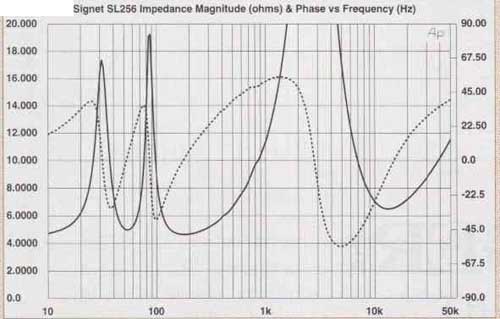
Fig.1 Signet SL256, electrical impedance (solid) and phase (dashed) (2 ohms/vertical
div.).
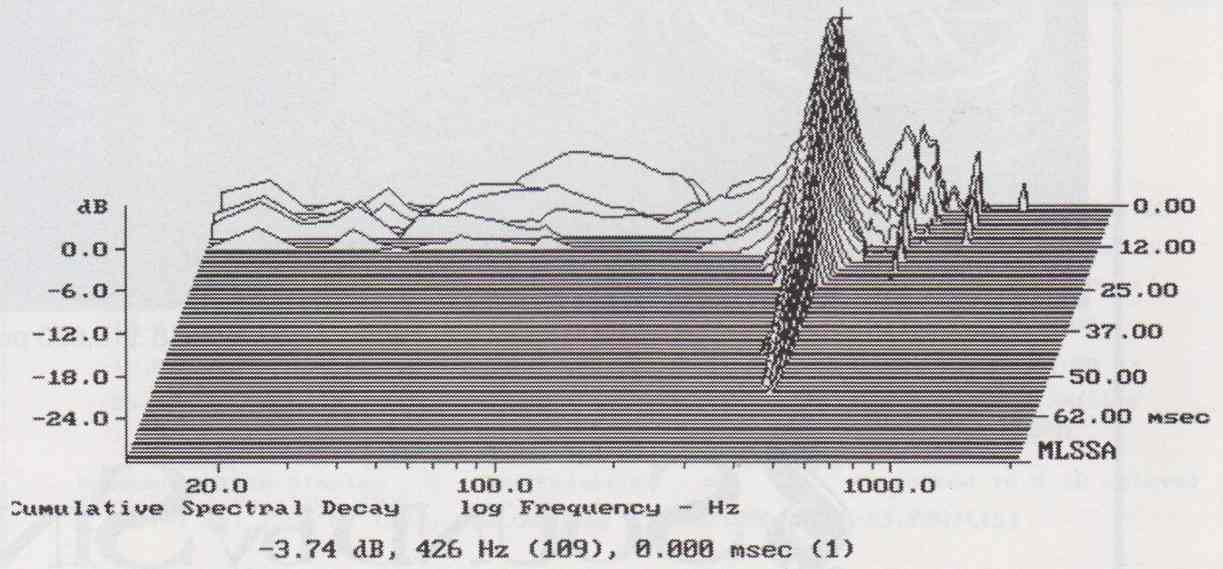
Fig.2 Signet SL256, cumulative spectral-decay plot of accelerometer output
fastened to cabinet sidewall. (MLS driving voltage to speaker, 7.55V; measurement
bandwidth, 2kHz.)
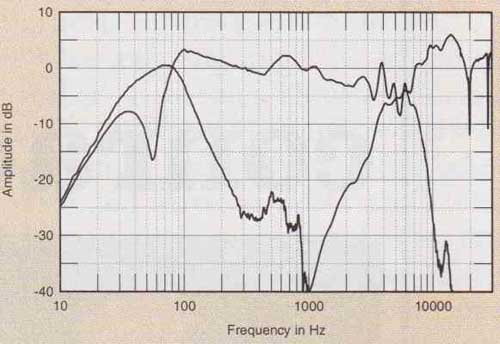
Fig.3 Signet SL256, acoustic crossover on tweeter axis at 50, corrected
for microphone response, with near-field woofer and port responses plotted
below 300Hz.
Turning to the frequency domain, fig.3 shows the individual responses of the tweeter, woofer, and port. The tweeter comes in higher than the specified 3kHz crossover frequency would suggest, with its output peaking above 8kHz. The woofer’s output peaks up in the upper bass, then gradually slopes down to the mid-treble, where its response is broken by a handful of peaks before a rapid rolloff above 7kHz. The woofer’s minimum-motion point occurs at 55Hz, the frequency of the “saddle” between the bass peaks in the impedance magnitude trace (fig.1, solid curve). The port’s maximum output actually occurs a little higher in frequency, however.
Fig.4 shows how these individual responses sum. As MK suspected, the upper bass peaks up. This is the old “LS3/5A trick,” where the designer exaggerates a mini-monitor’s upper bass to conceal the lack of low bass. While this can be quite effective (especially when allied to a top octave that is also somewhat exaggerated), it mandates that the speaker be used well away from room boundaries if it isn’t to boom. The midrange is reasonably smoothly balanced, though a peak in the upper midrange might make the speaker a little fatiguing on closely miked recordings. The peaks at the top of the woofer range also make their presence known in this graph, while the tweeter range is balanced to be a little hot. I note that MK did comment on the speaker having a slight “crispness” —probably due to the woofer peaks—though overall he found the treble and top octave “softened.
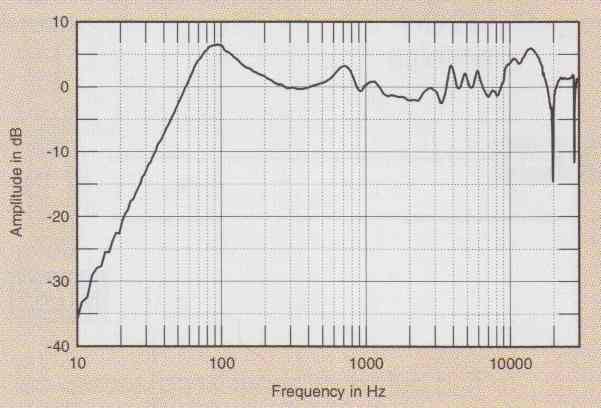
Fig. 4 Signet SL256, anechoic response on tweeter axis at 50’, averaged across
30 degrees horizontal window and corrected for microphone response, with
complex sum of near-field woofer and port responses plotted below 300Hz.
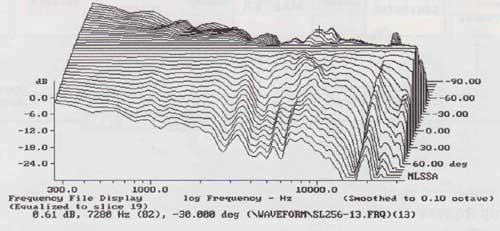
Fig.5 Signet SL256, horizontal response family at 50, normalized to response
on tweeter axis, from back to front: differences in response 90 degree -
50 off-axis; reference response; differences in response 50-90-degree off-axis.
This softening might be due to the speaker’s dispersion. However laterally (fig.5), the Signet’s response scents well- maintained off-axis, at least below 3kHz and between 7kHz and 12kHz. The speaker does appear to beam a little between 3 and 7kHz and above 12kHz, but not so much that I would have thought it to soften the treble. However, all things being equal, the lack of off- axis energy in the mid-treble will make the speaker sound more polite.
In the vertical plane (fig.6), the off-axis responses also have a lack of energy in the same region, due to destructive interference between the outputs of the two drive-units. In addition to making the speaker rather critical in terms of listening height—MK found that he got the best balance slightly below the tweeter axis—this, too will offset the Signet’s on-axis treble balance.
In the nine domain, the step response (fig.7) is absolutely conventional, with both drivers connected with the same positive acoustic polarity. The associated cumulative spectral-decay plot (fsg.8) is clean in the midrange and in the mid- treble and above, but is dominated by a woofer-cone resonant mode at 4kHz. Again, this probably correlates with MK finding the speaker “crisp.”
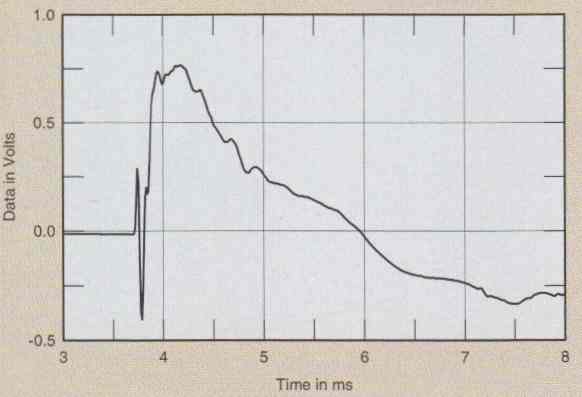
Fig. 7 Signet SL2S6, step response on tweeter axis at SO ( time window, 30kHz
bandwidth)
= = = = = =
Associated Equipment
CD Transport: Audio Electronics CD 1
Jitter Reduction: Audio Alchemy DTI Plus Monarchy DIP
D/A Processor: Parts Connection Assemblage DAC 2
Preamplifiers: Audio Electronics AE 2; NAD 1600
Power Amplifiers: home built Zen monoblocks; Sonic Frontiers Power 1; NAD 2100X
Loudspeakers: B&W 804
Digital Cables: Sound & Video Digiflex Gold I and Digiflex +Plus Illuminati DV-30.
Interconnects: TARA Labs RSC Prime Kimber PBJ
Speaker Cables: Straight Wire Maestro (hi wire pair) TARA Labs RSC Reference Gen 2 Speaker
Stands: May Audio TB888-24
Accessories: RoomTune Just-a-Rack with solid brass nuts home built isolation transformer power conditioner; AudioPrism CD Stoplight Acoustic Treatment: ASC Alpha Wedge foam panels blankets Warstar Surprise Attack Team X Men action figure
= = = =
To obtain the very best performance that the Signets were capable of it was necessary to try better stands. Luckily I had handy a pair of the very heavy, 24’ high, $550/pair May Audio TB888-24 stands. Though it’s unlikely that any one in the real world would use these stands with the SL256s —they cost more than the speakers — they did ensure that the Signets were performing at their optimum level. May Audio’s John Griton did a little research into the origin of the dense Malaysian rubberwood used in these stands, and found that it is a byproduct of the rubber industry. That certainly gets the big environmental OK sign from me. The six vertical members have thin lead inserts to minimize tinging, and indeed when I rapped them they rang no more than a concrete sidewalk. The stands come with good spikes that are easy to adjust.
The Signets were initially coupled to the TB888s with the four foam disks supplied with each stand. The sound was obviously better right away. On Steve Reich’s Octet (ECM New Series 1168), the bass clarinets were more solid and better fleshed out with the May Audios. The flute’s position was more distinct in the soundstage, which was now nice and wide. The lower mid/upper bass region was quicker and more authoritative. I was able to distinguish the identities of the different instruments, even when some of them played the same rhythms and melodies. The imaging was not as pinpoint as the 804s’, but the sweet spot seemed to be larger. (I love this piece of music; like many of Steve Reich’s compositions, it grows on you in a big way.)
In the interests of experimentation, I removed the TB888s’ pliant foam disks. I then placed the Signets directly on the stands, with one or two pieces of arc-proofing tape supporting each front corner. The stands were tilted back a little by raising the front spikes, and with the tape under the speakers’ front edges my eyes were on the axis of the upper edge of the woofer. The images became even more solid, and there was more space in the (artificial) soundstage. The cello had more body, and the piano sounded more like a piano. The violins’ treble was cleaner, more incisive.
Closely coupling the Signets to these excellent stands truly transformed them. If I were to write a song about my listening experience, two of the lines would be: “More precision and palpability / Greater micro-dynamic agility.”
While browsing through Stereophile’s “Recommended Components,” I noticed the passage that states: “... for speakers that need stands, every dollar spent on good stands is worth $5 when it comes to sound quality.” Initially I thought we must be crazy to print such a silly thing. I mean, we’re talking about stands here — they don’t even make any of the sound! [ Stands are not supposed to make any sound, but they do. Just like anything else in your listening room, stands can vibrate in unpredictable ways, emitting sounds that are not an exact replica of what is coming out of the speakers. The best stands are so dense or so stiff that they minimize any such intrusions.]
But after hearing the Signets sitting directly on the TB888s, I no longer doubted this recommendation. (Still, it might be a little extreme. A more realistic equation might be that $1 spent on stands equals $2 of sound quality.)
Overtaken by tweak fever, I placed the 2kg solid-steel slabs that normally weigh down my 804s on top of the Signets. The bass was even more solid! I then added 2kg concrete weights on top of the steel slabs. Bass instruments now had an even better sense of size, and the low end held its own better! These tweaks cost nothing — the junk was just lying around the house. Don’t you just love a free tweak?
The Signets were really singing now. There was a slight emphasis of the upper bass, though not enough to war rant searching for a better speaker position. The Signets in this setup could make you think that the knee in the price/performance curve for speakers starts lower than you might have previously believed. Like, below $400.
This is probably going to totally discredit my taste in music, but I absolutely loved the way heavy metal sounded on these speakers, in particular the greatest music ever recorded for staying awake while driving: Ratt’s Out of the Cellar (Atlantic 80143-2) and Dancin’ Undercover (Atlantic 81683-2). These discs sounded irresistible through the SL256s. Okay, so their lyrics are stupid and meaningless, and their singing is generally cheesy. But you can’t deny that lead guitarist Warren DeMartini is serious competition for Eddie Van Halen. His solos are at once lyrical, exciting, powerful, blisteringly fast, full of dexterity, and map out fascinating melodies. But the main reasons I love this stuff are the two rhythm guitars that fill entire songs with complex, dissonant chords. The way their rhythms lock in with those of the drums is something that everyone can enjoy, but that only someone who’s played in a rock band can truly appreciate.
I got great results from the SL256s using my home-built Zen amps, but I still wanted to try them with another high-end amp. A review sample of the Sonic Frontiers Power 1 arrived just in time for some listening with the Signets. It provided good articulation and truly glowing vocals when I put on Tears for Fears’ Raoul and the Kings of Spain (Epic EK 67318). The speakers sounded less rolled-off in the treble with this 0.3-ohm output impedance amplifier than with the Zen, which is rated at around 0.7 ohm.
Still listening through the Sonic Frontiers tube amp, I put on one of my old favorites, the Eurythmics’ Touch (RCA PCD1-4917). The Signets seemed to have a slight crispness that they hadn’t had before. Though it was hard to decide whether I was hearing a previously unnoticed tweeter resonance or if the top octave was merely less attenuated, this crispness was minor enough to ignore after a bit. The speakers sounded very human, even with sounds other than singing. Annie Lennox’s jungle-cat fierceness came across very well. Her vocals were highlighted by the speakers, but not too much. Bass guitar had a nice, rich, growling quality.
These speakers have no true low bass, and their midbass is rolled-off. However; what bass they do have is quite satisfying. The rear port makes fine-tuning of the distance to the rear wall necessary for a balanced bass response. Their particularly seductive midrange well serves vocal music, woodwinds, and guitars. The treble was a little forgiving, which should mate well with the sonic balance of bud get electronics. Despite the slightly soft balance, they did not shy away from uncovering subtle yet important musical details in the top end of their range. Their imaging and dynamics were very good for such low-priced speakers.
Conclusions
Spread the good news! True high-end speakers can be had for just $360/pair I was pleasantly surprised by the high level of sound quality that the Signet SL256s provided in my reference system. In no way could they match the sound quality of my B&W 804s, but they could come close enough to make such a comparison less ridiculous than I had thought. The Signets were indeed able to keep me happy during long listening sessions, and almost never made me feel as if I had to return to the much more expensive speakers in order to really hear the music. Highly recommended.
== == ==
(This article adapted from review in Stereophile, June 1997)
== ==
